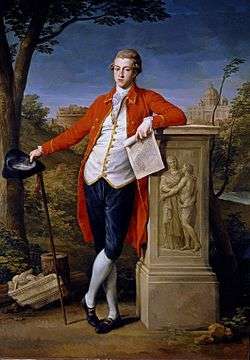Francis Basset, 1st Baron de Dunstanville and Basset

Francis Basset, 1st Baron de Dunstanville and Basset FRS (9 August 1757 – 14 February 1835) was an English nobleman and politician. He was the first son of Francis Basset and Margaret St. Aubyn (daughter of Sir John St Aubyn, 3rd Baronet).
Life
Basset was baptized at Charlbury, Oxfordshire on 7 September 1757 and educated at Harrow School (1770–71), Eton College (1771–74) and King's College, Cambridge (1775).[1] However, he left university for Italy in 1777, with the Revd. William Sandys as his cicerone. He passed through Rome, where he had his portrait painted by Pompeo Batoni (Batoni only finished it after Basset's departure, and - en route back to England on the Westmorland - it was seized by the French and sold to the Spanish). He returned to England in 1778, holding the office of Recorder of Penrhyn from that year onwards, and - like his father - being elected its Member of Parliament (between 1780 and 1796). The constituency returned two MPs, and one of his colleagues over that time was his cousin Sir John St Aubyn (son of Francis's mother's brother).
In August 1779,[lower-alpha 1] he marched 600 Cornish miners to Plymouth, strengthened that town's defenses and fortified Portreath, all of which helped counter a Franco-Spanish invasion fleet (gathered as part of the European theatre of the American Revolutionary War). As a reward, he was made 1st Baronet Basset, of Tehidy, county Cornwall on 24 November 1779. He married Frances Susanna Coxe, daughter of John Hippesley Coxe, at St Marylebone Parish Church on 16 May 1780, and finally graduated from King's College as a Master of Arts in 1786. He purchased Radnor House on the banks of the River Thames in Twickenham, which he owned from 1785 until 1793.[2]
He was made Baron de Dunstanville on 17 June 1796, and then Baron Basset, with special remainder to his daughter, on 30 November 1797. On his first wife's death, he remarried to Harriet Lemon (1777–1864, the fourth daughter of Sir William Lemon, first baronet, of Carclew, and Jane Buller) on 13 July 1824 but, though she survived him, they had no children. When he died without surviving male issue, his barony of Dunstanville became extinct as did his baronetcy, while the barony of Basset passed by special remainder to his only child, Frances, his daughter by his first marriage.
Legacy

On the highest point of Carn Brea in Cornwall is a 90-foot (27 m) high celtic cross, erected by public subscription in 1836. It is dedicated to Francis Basset and inscribed 'The County of Cornwall to the memory of Francis Lord de Dunstanville and Basset A.D. 1836.'[3][4] 50°13′16″N 5°14′56″W / 50.22111°N 5.24889°W
He is a recurring character in the Poldark novels by Winston Graham, where he is shown in a generally sympathetic light. The novels describe a long-standing struggle between Basset and George Boscawen, 3rd Viscount Falmouth for political supremacy in Cornwall.
Notes
- ↑ The History of Parliament describes him as lieutenant-colonel of the North Devon militia in this year, but an ode published in the Gentleman's Magazine of November 1802, p. 1048, makes it clear that it was his cousin Francis Basset who held this post.
References
- ↑ "Bassett or Basset, Francis (BST775F)". A Cambridge Alumni Database. University of Cambridge.
- ↑ "Radnor House". Twickenham Museum. Retrieved 10 June 2015.
- ↑ As shown by the stone inscription on the south of the monument. See inscription text on Basset Cross photograph
- ↑ "Tuesday's Post". Jackson's Oxford Journal. 17 September 1836.
A chaste and elegant monument from the chisel of Westmacott put up in parish of Illogan, Cornwall, to the memory of the late Lord De Dunstanville
External links
- History of Parliament Trust: House of Commons, Members 1790-1820, History of Parliament Trust biography
- Francis Basset on thePeerage.com
- Francis Basset - entry on Dictionary of National Biography
- Maria Dolores Sanchez-Jauregui, 'Two Portraits of Francis Basset by Pompeo Batoni in Madrid', The Burlington Magazine, Vol. 143, No. 1180 (Jul., 2001), pp. 420–425
- Angus McLellan, 'Pirates of the Mediterranean - mining the cargo of the Westmorland in Madrid', Trinity Today, December 2007, pages 14 to 15
- Giles Tremlett, 'Spaniards looted British art hoard', The Times, 1999
| Parliament of Great Britain | ||
|---|---|---|
| Preceded by Sir George Osborn William Chaytor |
Member of Parliament for Penryn 1780–1796 With: John Rogers 1780–1782 Reginald Pole-Carew 1782–1784 Sir John St Aubyn 1784–1790 Richard Glover 1790–1796 |
Succeeded by Thomas Wallace William Meeke |
| Peerage of Great Britain | ||
| New creation | Baron de Dunstanville 1796–1797 |
Extinct |
| New creation | Baron Basset 1797–1835 |
Succeeded by Frances Basset |